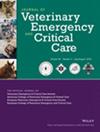Clinical Management of Euglycemic Ketoacidosis in a Cat With Congenital Diabetes Mellitus Treated With Insulin and Dapagliflozin
Abstract
Objective
To describe the medical management of euglycemic diabetic ketoacidosis (EDKA) after two administrations of dapagliflozin in a cat with congenital diabetes mellitus undergoing insulin therapy.
Case Summary
A 2-year-old neutered female domestic shorthair cat with a prior presumptive diagnosis of congenital diabetes mellitus was followed for 20 months. After several adjustments to insulin therapy, the cat was relatively stable on high doses of insulin glargine (8.3 IU/kg, SC, q 12 h) with persistent hyperglycemia. Due to concerns regarding the impact of chronic hyperglycemia in a young cat, treatment was started with dapagliflozin (10 mg/cat, PO, q 24 h). A reduced dose of insulin glargine (1.3 IU/kg, SC, q 12 h) was administered concurrently to minimize the risk of ketoacidosis. Forty-eight hours after the second dapagliflozin administration, the cat was admitted for lethargy, hyporexia, and vomiting. Bloodwork was consistent with ketoacidosis and hypokalemia. During initial treatment for diabetic ketoacidosis, the cat developed hypophosphatemia, hyperbilirubinemia, and increased liver enzyme activities, with normal interstitial glucose values despite cessation of dapagliflozin. Management consisted of 7.5% glucose supplementation, a constant rate infusion of short-acting insulin, and correction of electrolyte and acid–base derangements. Improvement was seen within 12 h of starting this protocol. The cat was discharged after 9 days of hospitalization. Sixteen days after the discontinuation of dapagliflozin, the cat's interstitial glucose concentration, liver enzyme activities, and serum bilirubin concentration returned to pretreatment values.
New or Unique Information Provided
With the introduction of sodium-glucose linked cotransporter 2 inhibitors, clinicians should be aware of EDKA and its management. This case report describes how the treatment of EDKA in cats, similar to treatment in people, may require proactive, aggressive glucose supplementation, treatment with short-acting soluble insulin, and vigilant electrolyte and acid–base monitoring. It also showcases the possibility of dapagliflozin having effect days beyond drug cessation.

 求助内容:
求助内容: 应助结果提醒方式:
应助结果提醒方式:


